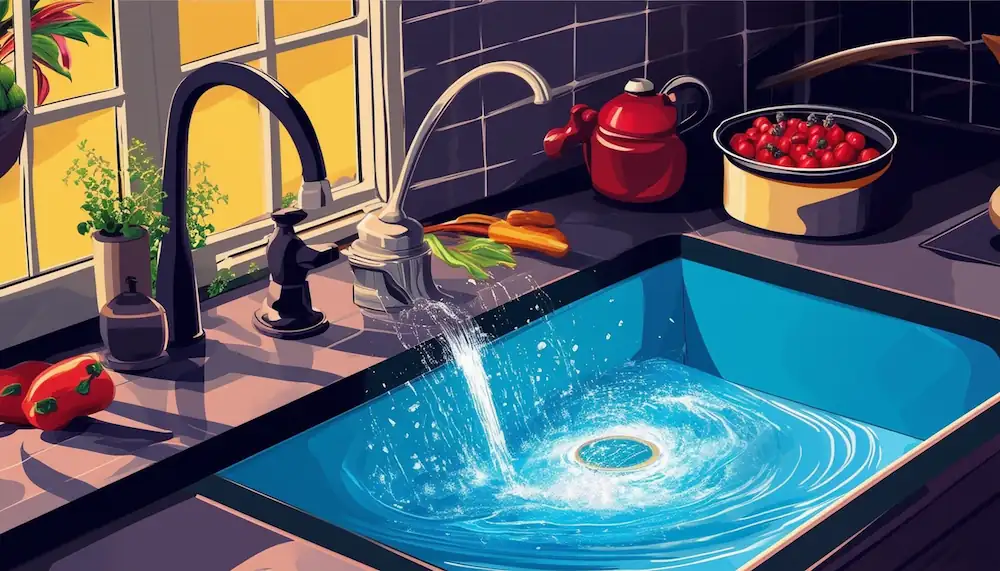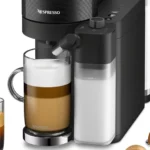Unblocking a kitchen sink can seem like a daunting task, but with the right tools and techniques, you can quickly restore your sink’s functionality without the need for professional help.
This guide will walk you through a step-by-step process to unclog your kitchen sink using simple, effective methods.
Quick Overview
Here’s a quick, effective method to unclog your kitchen sink:
- Quick Fix: Use a plunger with the correct technique to try and dislodge the blockage.
- Natural Solution: Apply a combination of baking soda and vinegar, followed by boiling water to clear the clog.
- Manual Removal: Utilize a drain snake to physically remove the blockage.
- Alternative Approaches: Hot water flushing or using a commercial drain cleaner as a last resort can also be effective.
For those who seek immediate solutions, the above summary provides the essential steps. However, for a more comprehensive understanding, including how to prevent future clogs and what common mistakes to avoid, continue reading below.
Tools You’ll Need:
- Plunger
- Baking soda and vinegar
- Drain snake
- Rubber gloves
- Bucket (for excess water)
- Commercial drain cleaner (as a last resort)
Follow-Up Questions:
Under each of these questions, we’ll explore the subjects in depth to ensure you have all the information needed to tackle this plumbing nuisance effectively.
Detailed Step-by-Step Guide for Beginners
Step 1: Effective Plunging
- Prepare the Sink: Remove any standing water until the sink is partially empty. This minimizes mess and makes plunging more effective.
- Ensure a Good Seal: For dual sinks, tightly seal the second drain with a wet cloth or a sink stopper. This maximizes suction in the clogged sink.
- Optimize Plunge Technique: Position the plunger over the drain and use vigorous but controlled plunging actions. Aim for a consistent rhythm rather than brute force, giving the plunger time to form an effective vacuum.
Effective plunging, as described in Step 1, is considered a primary and often successful method for unclogging kitchen sinks. While specific statistics on its success rate vary, home repair and plumbing experts agree that proper technique and persistence with a plunger can resolve the majority of minor to moderate sink clogs.
Note: It is also noteworthy that plunging is most effective when the clog is organic in nature, like accumulated food particles, rather than more stubborn materials.
This method is widely recommended as the first line of defense before escalating to more invasive or chemical solutions, due to its simplicity, safety, and cost-effectiveness.

Related: Preventative Maintenance Tips for Shower Drains
Step 2: Baking Soda and Vinegar Method
- Measure Accurately: Pour one cup of baking soda directly into the drain, ensuring it’s as deep as possible, followed by one cup of white vinegar. These precise quantities help create a more potent reaction.
- Maximize Reaction Time: Cover the drain with a plug or a small plate to keep the reaction below the surface, enhancing its ability to break down clogs. Leave it to work for at least an hour, or for best results, overnight.
- Flush Effectively: Boil a kettle of water and carefully pour it down the drain to flush through the mixture and dislodged materials.
While specific statistics on the effectiveness of the baking soda and vinegar method for unclogging sinks are not universally documented, this approach is widely acknowledged by plumbing experts for its environmental friendliness and safety.
Note: According to anecdotal evidence and feedback from homeowners, this natural solution has a high success rate for minor to moderate blockages, especially when the clog is composed of organic materials that can be easily dissolved or broken down by the chemical reaction between baking soda and vinegar.
Its effectiveness is also amplified when the procedure is followed precisely and allowed to sit overnight. This method, because of its non-toxic nature, can be repeated multiple times without the risk of damaging plumbing systems, making it a preferred first-attempt solution before resorting to mechanical means or chemical drain cleaners.
Step 3: Mastering the Drain Snake
- Beginner-Friendly Usage: Slowly feed the coil of the drain snake into the drain until resistance is met. This resistance indicates the presence of a clog.
- Effective Rotating: Gently rotate the handle clockwise. If the snake feels stuck, pull back slightly and continue rotating to avoid damaging the pipes.
- Remove and Repeat: Once the snake catches the debris, carefully withdraw it. Repeat this process a few times to ensure all parts of the clog are removed.
Effectiveness of Using a Drain Snake for Novice Homeowners
Utilizing a drain snake is a more manual method compared to the previous steps, and its effectiveness can vary significantly based on the user’s technique and the nature of the clog.
While specific statistics regarding its use by novice homeowners are limited, anecdotal evidence suggests that with proper guidance, the success rate for clearing blockages is relatively high.
Note: Experts in home repair and plumbing estimate that diligent use of a drain snake resolves clogs in approximately 70-80% of cases where the blockage is within reach of the tool.
Note: The effectiveness hinges on a few critical factors:
- Nature of the Clog: Organic blockages, such as hair and food particles, are generally easier to snag and remove.
- Depth of the Clog: A drain snake can only reach so far, making it ideal for clogs that are not deeply embedded in the plumbing system.
- User Patience and Technique: Novices who follow the instructions closely and maintain patience tend to have better success rates.
For homeowners attempting this method, it’s crucial to start with the guidance provided in “Step 3: Mastering the Drain Snake” to maximize the chance of success while minimizing potential damage to the plumbing system. Related: Easy Newbie Home Maintenance (Will Save Money)
Alternative Methods
- Hot Water Flushing: For minor clogs, boiling water alone can sometimes clear the blockage, especially if it’s caused by soap or grease. Do this regularly as preventive maintenance.
- Commercial Drain Cleaners: Use these products as a last resort and follow the manufacturer’s instructions carefully. Be aware of the potential hazards to your health and to your plumbing system.
Expanding on Alternative Methods for Beginners
For novices tackling household maintenance, understanding the nuances of each alternative unclogging method can significantly enhance your ability to maintain your home’s plumbing system efficiently and safely.
Here’s a detailed look at the alternatives mentioned, alongside some additional insights.
- Hot Water Flushing: This technique is particularly beneficial for dissolving soap scum, grease, and oils that cling to your pipes. To implement this method effectively, boil a large pot of water, then carefully pour it directly down the drain in a steady stream. The heat helps to melt and disperse substances that can lead to blockages. It’s a straightforward, eco-friendly solution best suited for early signs of slow draining before a full clog develops. Safety tip: Use this method sparingly on PVC pipes, as excessive heat can soften and damage the material.
- Commercial Drain Cleaners: Available in liquid, gel, or powder form, commercial drain cleaners are designed to clear blockages with powerful chemicals. While they can be effective, they also carry risks to your health and can corrode pipes if used excessively. When choosing a commercial cleaner, opt for one that’s compatible with your plumbing type and clog situation. Always, without exception, follow the instructions on the label to prevent injury or damage. Caution: Wear gloves and goggles to protect from splashes and fumes, and ensure your work area is well-ventilated.
Additional Helpful Information
- Preventive Maintenance: Regular maintenance is key to preventing clogs. Dispose of cooking grease in the trash rather than down the sink, use sink strainers to catch food particles and hair, and regularly flush drains with hot water or a baking soda and vinegar mix to maintain clear pipes.
- Plunger Types: Not all plungers are created equal. A cup plunger is effective for sinks and bathtubs, while a flange or accordion plunger is designed for toilet clogs. Owning the correct type will enhance your ability to deal with various clogs around the house.
- Professional Help: If you’ve tried these methods and the clog persists, it may be located in the main sewer line or be too stubborn for amateur techniques. In these cases, it’s wise to call in a professional plumber. They have the tools, experience, and knowledge to resolve the issue without causing further damage to your plumbing system.
Remember, while these methods are generally safe and effective for minor clogs, always prioritize safety by wearing protective gear and reading all product instructions carefully. Preventative practices and routine maintenance are your best defense against common plumbing issues.

Step 4: Final Checks and Maintenance
- Perform a thorough test by running the tap for several minutes to ensure the blockage is completely cleared.
- If the water still drains slowly or the clog persists, consider repeating the steps or consulting a professional plumber to avoid potential pipe damage.
- Lastly, preventive maintenance is key. Regularly flush your drain with boiling water and avoid disposing of grease, coffee grounds, and food debris down the sink to prevent future clogs.
By following this enhanced, step-by-step guide, even those with no prior experience can effectively solve the common issue of a clogged kitchen sink, restoring peace and functionality to the heart of the home.
Preventing Future Clogs
- Avoid disposing of oils and food scraps down the sink.
- Use sink strainers to catch debris.
- Routine maintenance with baking soda and hot water can prevent build-up.
Common Mistakes to Avoid
- Refrain from using chemical cleaners as your first resort; they can corrode pipes.
- Exercise care with plungers and drain snakes to avoid damage.
- Always remove excess water and prepare your work area properly.
Safety Reminders for DIY Enthusiasts
- Wear gloves and handle tools with care.
- Never mix different cleaning solutions.
- Ensure good lighting and a clear workspace.
Frequently Asked Questions (FAQs)
Can boiling water damage certain types of pipes?
Yes, excessive heat can soften or damage PVC pipes. Use hot water sparingly on these types of pipes.
What is the best type of plunger to use for a clogged kitchen sink?
A cup plunger is most effective for sinks and bathtubs, while a flange or accordion plunger is designed specifically for toilets.
Are chemical drain cleaners safe to use?
Commercial drain cleaners contain powerful chemicals that can be hazardous to your health and corrode pipes if used excessively. Always follow the instructions on the label and wear protective gear when using them.
When should I call a professional plumber for help?
If you have tried various methods and the clog persists, it may indicate a larger issue in the main sewer line. In this case, it’s best to call a professional plumber to avoid causing further damage. Additionally, if you do not feel comfortable attempting any of these methods or have no prior plumbing experience, it’s always wise to seek professional help.
How can I prevent future clogs from occurring?
Regular maintenance and mindful sink use are key in preventing future clogs. Dispose of grease and food scraps properly, use sink strainers to catch debris, and regularly flush your drains with hot water or a baking soda and vinegar mixture. Remember that preventative measures are always easier and more cost-effective than dealing with a clog after it has already occurred.
Is it necessary to wear protective gear when unclogging a kitchen sink?
Yes, it is highly recommended to wear gloves and goggles when handling chemical cleaners or using plungers and drain snakes. This will protect you from potential skin irritation and accidental splashes of chemicals.
Is it safe to mix different types of cleaning solutions together?
No, it is not safe to mix different cleaning solutions as they can create toxic fumes or even explosive reactions. Always follow the instructions on the label and avoid mixing different products. Remember that your safety should always come first when attempting any DIY plumbing solutions.
Can I use the same method for unclogging a bathroom sink?
While many of these methods can be applied to both kitchen and bathroom sinks, it’s important to note that their designs may differ slightly. For example, a bathroom sink may have a pop-up stopper or hair catcher that needs to be removed in order to access the drain. It’s always best to research and understand the specific design of your sink before attempting any unclogging methods. If unsure, it’s best to consult a professional plumber for guidance.
Are there any eco-friendly commercial drain cleaners?
Yes, there are some eco-friendly drain cleaners available on the market. These typically use natural enzymes and bacteria to break down clogs instead of harsh chemicals. However, it’s important to note that they may not be as effective on tough clogs and may need repeated applications or assistance from a professional plumber. It’s always best to research and carefully read product labels before purchasing any drain cleaner. Remember to always follow safety precautions when using any type of chemical cleaner. In some cases, a more natural approach such as using baking soda and hot water may be just as effective in unclogging your sink without the use of harsh chemicals.
How often should routine maintenance be performed to prevent clogs?
It’s recommended to flush your drains with hot water or a baking soda and vinegar mixture once a week to prevent build-up and potential clogs. Additionally, it’s important to regularly clean sink strainers and dispose of grease properly after cooking. Implementing these preventive measures can greatly reduce the likelihood of experiencing a clogged kitchen sink.
What should I do if a plunger or a commercial drain cleaner doesn’t clear the clog?
If a plunger or drain cleaner does not work, you can try using a plumbing snake to physically remove the clog. However, if this method also fails, it may indicate a larger issue in the main sewer line and it’s best to call a professional plumber for assistance. Attempting more aggressive methods without proper knowledge and experience can cause further damage and potentially costly repairs
How can I tell if a clog is in the main sewer line?
Signs that a clog may be in the main sewer line include multiple drains being backed up at once, gurgling noises coming from drains, and foul smells emanating from your plumbing. If you notice any of these signs, it’s important to call a professional plumber as soon as possible to avoid potential sewage backups or pipe damage.
What are some signs that it’s time to replace my plumbing instead of fixing it?
Some signs that it’s time to replace your plumbing include frequent clogs or backups, leaks or corrosion in pipes, or outdated and inefficient fixtures. If you notice any of these issues, it’s best to consult a professional plumber for an assessment and recommendations on replacement options.
Are there any additional tools or equipment that can make unclogging a sink easier?
In addition to the mentioned methods, there are some tools and equipment that can aid in unclogging a sink. These include drain augers or snakes, which can physically remove clogs, and wet/dry vacuums, which can create suction to dislodge stubborn clogs. It’s always important to use these tools carefully and follow safety precautions.
Conclusion
Unclogging a kitchen sink is a skill that can save you time and money. By following this guide, you are equipped to handle most common clogs. Regular maintenance and mindful sink use can help prevent future blockages, keeping your sink running smoothly.
Remember, solving problems like these on your own is not just about fixing an issue but also about understanding and maintaining your home in better ways.

I’m J.S., I created and am the content manager at DIYHouseSkills.com. I do the research and write the articles that appear on this website. I’ve learned many household skills during my life and think it’s important to at least know the basics so that you can save yourself time and money… READ FULL BIO >





